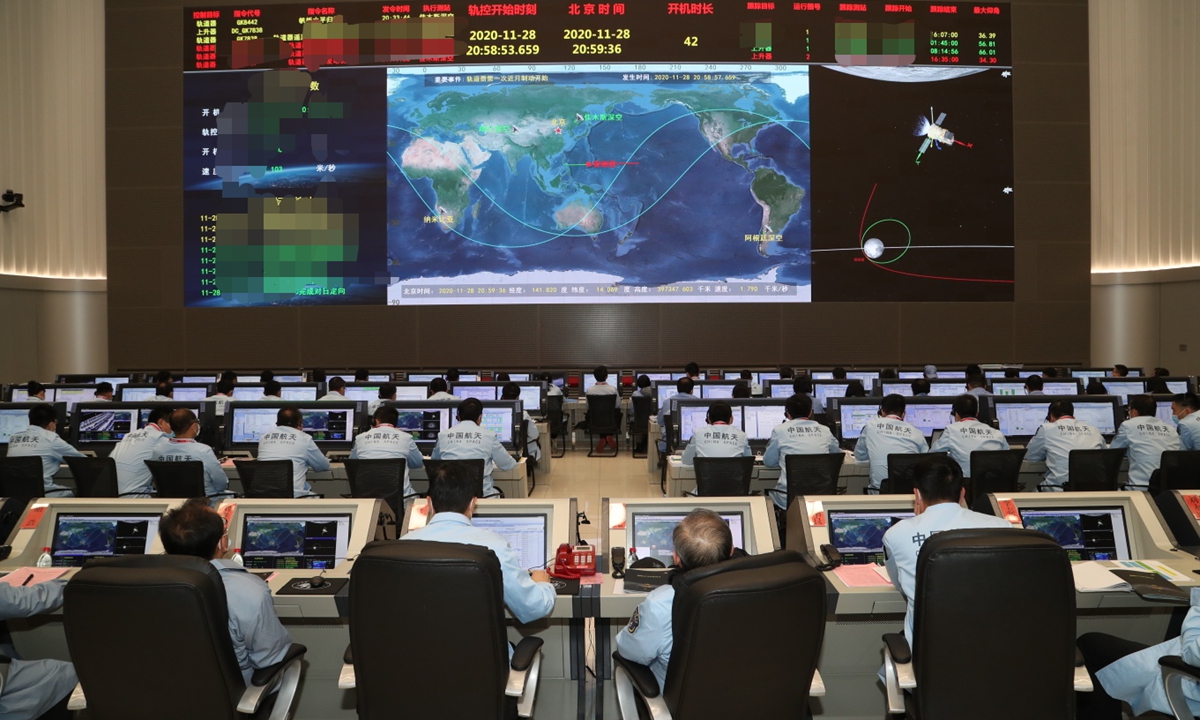Previous mission experience to ensure safe soft landing for Chang’e-5, likely on Tuesday: space analysts
By Deng Xiaoci and Fan Anqi Source: Global Times Published: 2020/12/1 13:41:49

Chinese space engineers watch Chang'e-5 lunar probe carry out a braking maneuver to enter the moon's orbit on Saturday. Photo: Song Xingguang, Yan Xiaolie, Zhao Yuliang/Our Space
The lander-ascender combination of China's robotic lunar probe, Chang'e-5, is expected to carry out a soft landing on the moon soon, after Monday's announcement by the China National Space Administration (CNSA) revealed that the probe had completed controlled separation into the said combination and orbital module comprising orbiter and re-entry capsule.
Astronomy enthusiasts from all over the world are closely following every step the Chinese probe is taking, and many on Twitter speculated that Chang'e-5 will attempt a moon landing as soon as Tuesday.
The CNSA had not disclosed the exact date of the moon landing operation as of press time. It only said in its latest statement on the probe mission on Monday that "the lander-ascender combination will carry out soft landing at a suitable time, and perform lunar sample collecting and other work."
Space analysts reached by the Global Times expressed high confidence of success for the upcoming Chang'e-5 moon landing operation, as previous landing missions by Chang'e-3 and Chang'e-4 on the dark side of the moon accumulated abundant experience for the probe's automatic decision-making capability as well as its engine system.
Pang Zhihao, a former researcher at the China Academy of Space Technology and a space science author, said that safety would be the top consideration in deciding when the lander-ascender combination performs its moon landing.
The landing ground should be as flat as possible, and the angle of dip should be no more than 15 degrees, as these conditions would not only ensure the safety of the landing, but also make it easier for the Chang'e-5 ascender to launch from the lunar surface, Pang told the Global Times on Tuesday.
The Chang'e-5 is set to touch down in an area that has never been visited either by probe or human. The landing site is in a massive lava plain known as Oceanus Procellarum, or "Ocean of Storms" - a region in the northwest corner and the largest lunar mare, which is visible to the naked eye from Earth.
Space observers hailed the choice of landing site as being both innovative and having scientific value.
Scientists believe that the rocks and soil in the region are only 3.2 to 4 billion years old. Compared with previous lunar samples that have been brought back to Earth, it will help scientists better understand the Moon's volcanic activities.
The lunar material that the Chang'e-5 probe will collect was formed from the space weathering of lunar rocks after a meteorite impact, solar wind and cosmic ray radiation. It consists of a considerable amount of rock fragments, minerals and meteorites, which provide valuable information for studying the geological evolution of the moon, as well as solar activities, Xiao Long, a professor at the Wuhan-based China University of Geosciences, previously told the Global Times.
Global Times has learned from the state-owned space industry giant China Aerospace Science and Technology Corporation (CASC) that a 7,500-newton thrust-variance engine along with 16 altitude control engines will help the vehicle slow down to a speed that allows the aircraft to carry out a soft landing, while keeping it at a normal position.
The technology was previously applied in the Chang'e-3 and Chang'e-4 missions, according to the CASC.
The artificial intelligence-powered probe will also perform a "smart landing" on its own, saving the trouble of having to use long distance signal transmission. The lander can only send signals to Earth once every 1.3 seconds, and then receive command several seconds later, which could waste a great deal of time if it relies on ground commands from the Earth, space observers explained.
The Chang'e-3 mission proved that the spacecraft's autonomous decision-making can make the detector extend its four legs and land safely on flat land. Even on more complex terrain on the far side of the Moon during the Chang'e-4 mission, it successfully completed the landing task all by itself, they said.
Observers concluded that with its previous experience, the smart soft landing of the Chang'e-5 will be a lot safer and easier than before.
The Chang'e-5 probe was launched by the Long March-5 Y5 carrier rocket from Wenchang Space Launch Center in South China's Hainan Province on November 24, and the entire mission will last around 23 days.
The unmanned mission, named after a lunar goddess in Chinese mythology, aims to bring around 2 kilograms of lunar materials back to Earth, and if successful, it will be the first time it has been done since US and Soviet missions did so in the 1960s and 1970s, media reported.
Posted in: SOCIETY